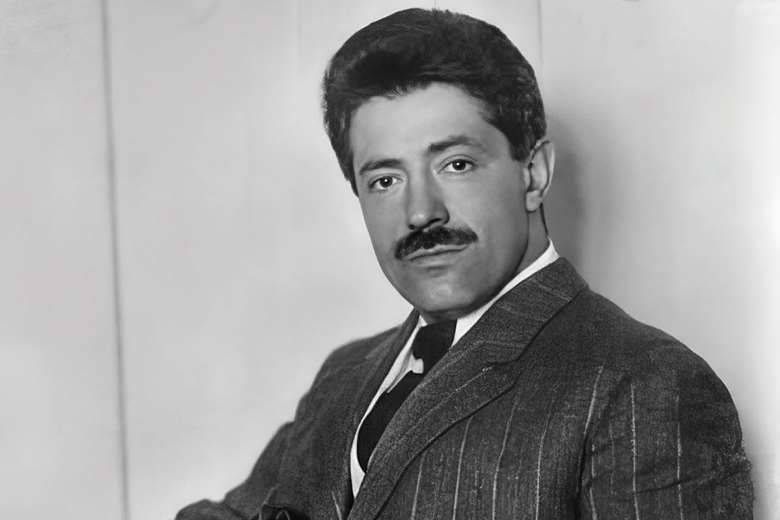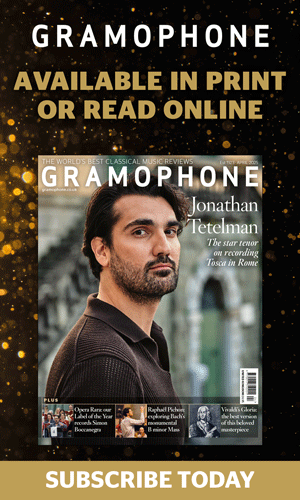Icon: Fritz Kreisler
Tully Potter
Friday, August 9, 2024
Tully Potter celebrates the prototypical Viennese-style violinist who for half a century was adored among peers, critics and audiences, and who made hundreds of recordings

When we invoke the Viennese violin style, we are really speaking about one man, Fritz Kreisler. Others with a similarly lilting way of playing, such as Erica Morini, Willi Boskovsky and today’s Rainer Honeck, have cheerfully trundled along in his wake. In Kreisler’s hands, the violin had a unique voice: it did not just sing, it radiated a spectrum of hues, distilling a blend of warmth and sweetness that was rarely cloying, because it was so musically deployed. His double-stopping was legendary and he coloured notes by placing his fingers in unusual positions.
He could weave this spell on quite humble instruments. Myriad violins by famous makers passed through his hands, but also some to which most rivals would not give a second look. When he came to London to record concertos, orchestral players crowded round, begging him to try their fiddles; and when he obliged, they had never before heard such sounds issue from their implements.
Kreisler’s gifts extended to piano playing – he and Harold Bauer once performed Beethoven’s Kreutzer Sonata at a concert in Portland, Oregon, then swapped instruments to play it again at the party afterwards – and to being memorably creative: ‘I began to compose and arrange as a young man. I wanted to create a repertory for myself,’ he said.
Vibrato was the main secret of his playing. Leopold Auer equipped his St Petersburg pupils with excellent vibratos, and players of the Franco-Belgian school had been evolving the silvery vibrato heard on Eugène Ysaÿe’s records; but Kreisler brought this device home from his studies in Paris and developed it out of all recognition.
In his hands, the vibrato was constant, starting at the outset of each note, with none of that horrid mid-note adjustment we hear from some violinists today. When Kreisler reached Britain, just after the turn of last century, his vibrato was a revelation to Lionel Tertis, who immediately adapted it to the viola.
We can trace its influence on the English cellist William Henry Squire, whose 1898 and 1901 discs reveal a typical Victorian, employing virtually no vibrato. Meanwhile, Pablo Casals brought his own variation of the Kreisler sound to the UK in 1899. By the time he next recorded, in 1906, Squire had developed an excellent vibrato; and in his 1911 HMV series this aspect of his technique was fully formed.
There was something in the air at this time: the Ukrainian prodigy Mischa Elman – 16 years younger than Kreisler – was forming the other wing of a two-pronged attack on prevailing attitudes in string teaching, a notoriously conservative profession. But Kreisler’s playing was subtler than Elman’s.
Kreisler nearly became a doctor and amateur musician like his father, and he even tried to get into the Vienna Court Opera Orchestra. Leader Arnold Rosé turned him down – cynics allege Rosé feared such a rival, but I suspect he simply thought the young upstart would stick out like a sore thumb.
Kreisler was notoriously indolent and reluctant to practise. Stories are legion of his arriving for a gig and saying: ‘I must check on my violin – I haven’t touched it for a week.’ He was one of the blessed few who could pick up the fiddle and get a good sound straight away – the Czech violinist Josef Suk (1929-2011) was another.
Interestingly, Kreisler always had the bow hair very tight, whereas George Enescu preferred it quite loose. These two and others of their time such as Adolf Busch were adept at slowing down the bow speed to make the violin ‘speak’ – parlando bowing that seems to be a lost art now.
Kind, generous and cultured, for half a century Kreisler was the most adored violinist among his peers, critics and the public. He survived the Great War, Jascha Heifetz’s explosive arrival, Hitler’s rise, a scandal over his compositions, the invasion of Austria and emigration to New York. His wife, Harriet, a termagant with a positively ‘Harpic’ personality, kept his nose to the grindstone.
He loved making music with friends. Once when he and John McCormack were messing about at the tenor’s home, McCormack delightedly told his wife: ‘I made a sound just like Fritz!’
A blot on Kreisler’s copybook – or an uproarious joke – was the storm that engulfed him in 1935.Needing to discuss the ‘Pugnani’ Praeludium and Allegro in a lecture recital with Yehudi Menuhin, New York Times critic Olin Downes asked Kreisler about the location of the original manuscript, and in a cable the violinist came clean: his ‘Classical Manuscripts’, 17 pieces plus a ‘Vivaldi’ Concerto, were virtually his own inventions. The controversy made headlines worldwide, although most colleagues had long guessed the truth. Elman was upset, some critics were censorious (Ernest Newman got particularly huffy), but the general mood was amused tolerance, and violinists still play much of the music.
Kreisler made hundreds of records, including the Bach Double Concerto with Efrem Zimbalist (slightly cut), three sonatas (by Beethoven Grieg and Schubert) with Rachmaninov, duets with McCormack and his own String Quartet with three London players. Some things were missed, such as his Praeludium and Allegro and the Franck Sonata. For the Beethoven, Brahms and Mendelssohn concertos and Mozart’s Concerto in D, I prefer the 1920s versions. The Beethoven sonatas are a mixed bag, as he would feature only the Kreutzer in his concerts; he muffs the off-beat Scherzo of the Spring Sonata.
For decades, like his friend Rachmaninov, he set his face against playing on the radio; but after Rachmaninov’s death in 1943, Harriet persuaded him to accept $5000 per appearance from the NBC concert series The Bell Telephone Hour. These performances survive. Between them, the Biddulph and Naxos labels have done his legacy proud.
Kreisler spent his twilight years holding court in his agent’s front office, partly to escape from Harriet. His 80th and 85th birthdays were opportunities for his colleagues to pay homage. Kreisler represents something irreplaceable, a confluence of a magical sound, an easeful style and a more leisurely era that can never be recreated.
Defining moments
• 1882 – Youngest entrant to Vienna Conservatory
Was born Friedrich Kreisler, Vienna, February 2, 1875. Reading music at age three. Violin lessons from father and Jacques Auber. Enters Vienna Conservatory age seven, studies with Jakob Dont and Josef Hellmesberger Jnr (violin), Bruckner (composition). Same year, debut at Carlsbad with singer Carlotta Patti, Adelina’s sister
• 1885 – Vienna Conservatory gold medal at 10
Following win, enters Paris Conservatoire: studies with Lambert Massart (violin), Delibes and Massenet (composition). 1887: conservatoire premier prix in violin. 1888-89: tours US with pianist Moriz Rosenthal. 1890-96: studies medicine, does military service. 1896: finally opts for music career. Tours Russia
• 1898 – Professional European debuts commence
Vienna: Bruch Concerto No 1, under Hans Richter. 1899: Berlin Philharmonic, Bruch No 2, Vieuxtemps No 2, Paganini ‘Non più mesta’ Variations; later same year, Mendelssohn under Arthur Nikisch. 1901: tours US. 1902: London debut, Beethoven under Richter; marries Harriet Lies. 1904: Philharmonic Society Gold Medal; first records, Gramophone & Typewriter Limited, Berlin
• 1910 – Premieres Elgar Violin Concerto under composer
He challenged Elgar to write it for him. 1914: wounded in war while serving in Austrian army; moves to US. 1919: his operetta Apple Blossoms (written with Victor Jakobi) opens in New York
• 1921 – Welcomed back to London
Makes recordings for HMV while in England. 1923: tours Japan and China. 1924: moves to Berlin. 1932: composes operetta Sissy. 1933: refuses to play in Nazi Germany
• 1935 – Unwelcome headlines
Scandal when he admits ‘Baroque’ pieces are his own work
• 1941 – Victim of street accident
Having become French citizen and immigrated to US in 1939, knocked down by truck, New York, in coma for four weeks. 1943: becomes US citizen. 1944: radio debut. 1947: last public concert, Carnegie Hall
• 1950 – Retires
Celebrations for 75th birthday. Dies New York, January 29, 1962
This article originally appeared in the September 2024 issue of Gramophone. Whether you want to enjoy Gramophone online, explore our unique Reviews Database or our huge archive of issues stretching back to April 1923, or simply receive the magazine through your door every month, we've got the perfect subscription for you. Find out more at magsubscriptions.com







